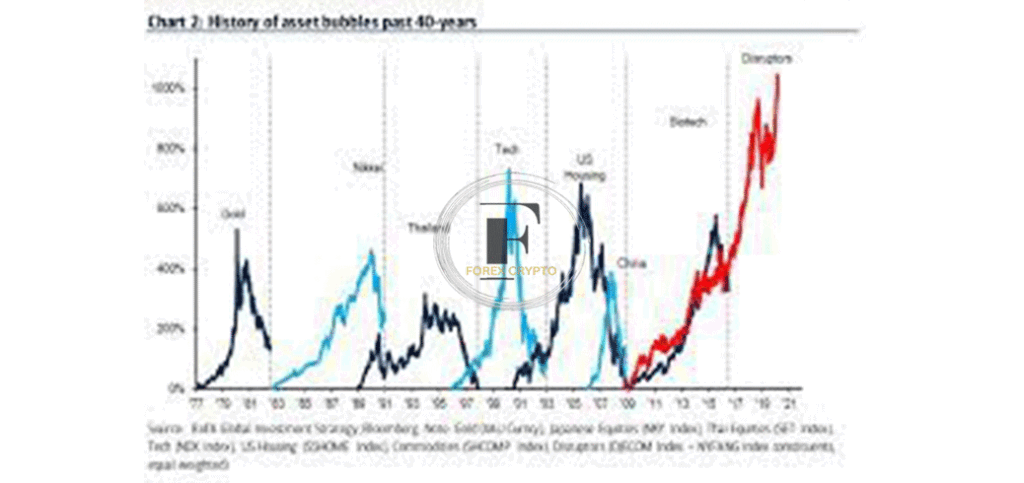stock market bubbles
In this article, we examine the nature of stock market bubbles as well as the strategies that might help investors avoid them.
Everyone anticipates that stock markets will go up and down; nobody stays on top for an extended period of time. On the other hand, for the whole of the year 2021, we were exposed to a plethora of stories that discussed various stock markets throughout the world achieving all-time highs. Alone in 2021, the stock market in the United States has already reached more than fifty new highs.
The majority of us will be relieved and relieved to witness a speedy recovery following the epidemic. On the other hand, it is important to keep a tight check on recoveries such as these to make certain that prices and values are not getting too out of hand.
When it comes to possible bubbles in the stock market, we have investigated what we can learn from history and how to successfully navigate through them. Even while we are not claiming that we are now in one or that we are moving in that direction, it is important to know what signs to watch out for.
This essay is not intended to serve as personal counsel. Since the value of any investment may go up as well as down, you run the risk of receiving back less money than you put in. Consult with a financial advisor if you are unsure whether or not a certain investment is appropriate for you.
Who blows the bubble?
While every bubble is different, there are a few traditional indicators that one may be developing.
Bubbles in the stock market occur when share values continue to grow for an extended period of time, ultimately becoming overpriced. This indicates that individuals are prepared to pay more for an investment than it is really worth, taking into consideration factors such as profits, revenue, or growth potential.
Alterations to an economy may also give rise to a bubble’s formation. When interest rates are historically low, as they have been for the past ten years, it may convince more individuals to invest more of their money and save less. Alternatively, the act of introducing additional money into an economy by a central bank, such as the Bank of England or the Federal Reserve in the United States. Price increases may be caused by either factor.

The news and the feelings of investors all contribute to the day-to-day movement of the market, which is a daily reflection of the short-term volatility that characterizes markets.
It is possible for prices to rise as a result of continued speculation by investors who are under the impression that the worth of a certain firm or industry will rise in the near future.
As an investor, one of your primary concerns should be the worry that you will lose out on opportunities. In today’s fast-moving and often turbulent market environment, it is easy to get the impression that there is a lot that you may be passing up.
At times like these, it may be easy to let go of solid investment discipline and ideas like thinking long-term, especially if the market is doing poorly.
It is essential to keep in mind that even if you have no influence over the market, you do have power over how you respond to any fluctuations in the market.
Bubbles from the past
There have been several bubbles throughout history at various times. Dot-com fever is perhaps the one that has received the most attention. People were eager to pay anything to be a part of the revolution that was about to take place in the globe brought about by technological, e-commerce, and telecommunications firms.
In 1999, the US technology-focused NASDAQ index had an increase of 86%, and by November of that year, average prices had hit 170 times earnings. At one point, Yahoo’s value exceeded that of both General Motors and Ford combined; hence, investors were ready to pay 1,000 times Yahoo’s profits for the next year.

There was an abundance of revolutionary ideas as well as promises of future profit growth. Nonetheless, there was often a dearth of genuine earnings or strategies to generate them. Many people have discovered, the hard way, that promise on its alone does not provide a stable basis for investments.
Amazon was one of the excellent ideas that were thrown into the pot in the end; the other good ideas included. Yet at the time, it wasn’t apparent which firms and technologies would come out on top; in fact, the competition was designed so that anybody might come out on top.
When considering whether new businesses or topics to invest in, we believe that it is preferable to wait until prospective winners are obvious before making any decisions.
What can we learn from past stock market bubbles?
Some assets are just now beginning to catch up with the values they held before the epidemic, so it may seem as if they have reached new heights. So, their assessments aren’t too far off the mark.
For others, on the other hand, it has been the norm to observe ridiculously high values, regardless of the climate.
There is not a single tale that has stoked the imaginations of investors for the next great thing, like the internet being the cause of the dot-com boom. But, there are still several industries in which you should err on the side of caution.
Recent events in the news have brought attention to various developments in technology. All of these innovations, such as self-driving automobiles, electric vehicles, and cryptocurrencies, seem to have the potential of ushering in a revolutionary new era. In addition, a large number of investors are becoming excited about the prospects of high prices.
Some of the promises could be fulfilled. If a certain investment or trend, however, has everyone talking about it, it is often time to explore elsewhere for opportunities.
Keep in mind that your previous results are not always an indicator of your future success.
What should investors do?
It is not always easy to see stock market bubbles, and by the time you do notice them, it may be too late to do anything about them.
To put up a diverse portfolio is thus very necessary. When you diversify your assets, you distribute your capital over a variety of asset classes, market segments, and geographic regions. This assists in distributing risk.
For instance, if one industry is booming, it can be worthwhile for investors to investigate other industries that aren’t as well known. Bubbles in one stock market may still be felt in other markets even after they have burst, so it doesn’t mean a market crash won’t be excruciating to watch if it does happen. Yet, the finest performers often appear in waves, which is why it is better to keep a mix.
If you have established a portfolio that is adequately diversified but now believe that you may have too much in one area or that a portion of it may be overpriced, this may be the ideal time to analyze and rebalance your portfolio.
When you rebalance your assets, you are bringing them back to their original proportions in your portfolio.
Let’s say you’ve made the decision to split your investment portfolio evenly between stocks and bonds. We’re not arguing that this is the optimal allocation; we’re simply using it to make the arithmetic more straightforward for this illustration.
If your bonds grew at a slower pace than the value of your shares, the proportion of your portfolio that was invested in shares would rise over fifty percent, making the portfolio riskier than it was when you started.
In order to get some assistance, you may want to think about selling some of your assets that have done well in order to put more money into those that have done badly. That may seem counterintuitive, but considering that top performers often come in waves, doing so will help put your portfolio back into kilter.




Comments (No)